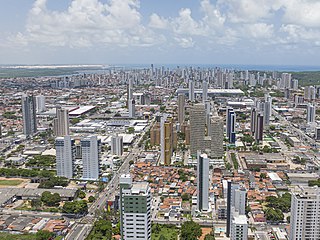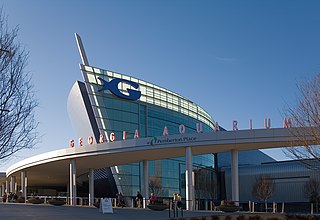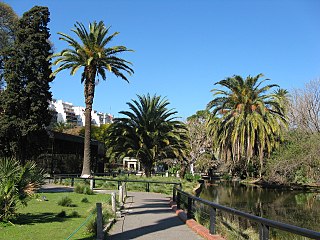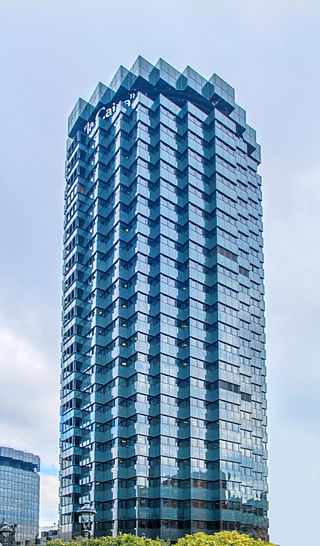
Shedd Aquarium is an indoor public aquarium in Chicago. Opened on May 30, 1930, the 5 million US gal aquarium holds about 32,000 animals and is the third largest aquarium in the Western Hemisphere, after the Georgia Aquarium and Monterey Bay Aquarium.

Mazatlán is a city in the Mexican state of Sinaloa. The city serves as the municipal seat for the surrounding municipio, known as the Mazatlán Municipality. It is located on the Pacific coast across from the southernmost tip of the Baja California Peninsula.

Natal is the capital and largest city of the state of Rio Grande do Norte, located in northeastern Brazil. According to IBGE's 2022 estimate, the city had a total population of 751,300, making it the 19th largest city in the country. Natal is a major tourist destination and an exporting hub of crustaceans, carnauba wax and fruits, mostly melon, sugar apple, cashew and papaya. Natal is Brazil's closest city to Africa and Europe, its Greater Natal International Airport connects the city with many Brazilian destinations and also operates some international flights. The city was one of the host cities of the 2014 FIFA World Cup.

Georgia Aquarium is a public aquarium in Atlanta, Georgia, United States. It exhibits hundreds of species and thousands of animals across its seven major galleries, all of which reside in more than 11 million US gallons (42,000 m3) of water. It was the largest aquarium in the world from its opening in 2005 until 2012 when it was surpassed by the S.E.A. Aquarium in Singapore and the Chimelong Ocean Kingdom in China; the Georgia Aquarium remains the largest aquarium in the United States and the fourth largest in the world.

A dolphinarium is an aquarium for dolphins. The dolphins are usually kept in a pool, though occasionally they may be kept in pens in the open sea, either for research or public performances. Some dolphinariums consist of one pool where dolphins perform for the public, others are part of larger parks, such as marine mammal parks, zoos or theme parks, with other animals and attractions as well.

Los Cabos is a municipality located at the southern tip of Mexico's Baja California Peninsula, in the state of Baja California Sur. It encompasses the two towns of Cabo San Lucas and San José del Cabo linked by a thirty-two-km Resort Corridor of beach-front properties and championship golf courses.

The Lerma River is Mexico's second longest river.

The Buenos Aires Eco Park is an 18-hectare (44-acre) park in the Palermo district of Buenos Aires, Argentina. The former zoo, opened in 1888, contained 89 species of mammals, 49 species of reptiles and 175 species of birds, with a total of over 2,500 animals. The institution's goals are to conserve species, produce research and to educate the public. In June 2016 the city formed a bias about the zoo's cruelty. They had to close the 140-year-old zoo and relocate most of the animals to nature reserves, including Temaikèn. The zoo property will be converted into an ecopark.

A public aquarium (pl. aquaria) or public water zoo is the aquatic counterpart of a zoo, which houses living aquatic animal and plant specimens for public viewing. Most public aquariums feature tanks larger than those kept by home aquarists, as well as smaller tanks.

CaixaBank, S.A., formerly Criteria CaixaCorp, is a Spanish multinational financial services company. CaixaBank is based in Valencia, with operative offices in Madrid and Barcelona, Spain. It is Spain's third-largest lender by market value, after Banco Santander and BBVA. CaixaBank has 5,397 branches to serve its 15.8 million customers, and has the most extensive branch network in the Spanish market. It is listed in the Bolsa de Madrid and is part of the IBEX 35.

Species360 founded in 1974, is an international non-profit organization that maintains an online database of wild animals under human care. As of 2023, the organization serves more than 1,300 zoos, aquariums and zoological associations on six continents and in 102 countries worldwide. The organization provides its members with zoological data collection and management software called ZIMS—the Zoological Information Management System.

Valencia's Aquarium is a recreational park located in Valencia, Venezuela. It is the largest aquarium in Venezuela, and it also has a small zoo with species from Venezuela. It is operated by the J.V. Seijas Foundation.

An aquarium is a vivarium of any size having at least one transparent side in which aquatic plants or animals are kept and displayed. Fishkeepers use aquaria to keep fish, invertebrates, amphibians, aquatic reptiles, such as turtles, and aquatic plants. The term aquarium, coined by English naturalist Philip Henry Gosse, combines the Latin root aqua, meaning 'water', with the suffix -arium, meaning 'a place for relating to'.

Catemaco Municipality is a municipality in the Mexican state of Veracruz. It is located in the state's Los Tuxtlas region. The municipal seat is the city of Catemaco.

The Rodadero Sea Aquarium and Museum is a public aquarium and maritime museum located in the Inca Inca Cove off the Rodadero beach in Santa Marta, Colombia. It was opened in 1965 by Captain Francisco Ospina Navia. The aquarium is part of the National Network of Museums of Colombia and part of ACOPAZOA, the Colombian branch of the World Association of Zoos and Aquariums. Accessible mainly by motorboat, the aquarium has 13 pools with direct connection to the Caribbean Sea, and 15 glass aquaria that contain over 805 animals that include sharks, sea turtles, dolphins, sea lions, crustaceans, fishes and seabirds, 98% of which are native to the area.

The Marine Aquarium of Rio de Janeiro, or AquaRio, is a public aquarium located in the Gamboa neighborhood, in the port zone of Rio de Janeiro, Brazil. With a constructed area of about 26,000 square metres (280,000 sq ft), it is located to the west of Muhammad Ali Square. It is considered the largest marine aquarium in South America.

The Acuario de Veracruz is a public aquarium located in the city of Veracruz. It is the biggest aquarium in Mexico and Latin America by water volume, with 7 million liters of water.

Acuario Michin Guadalajara is an aquarium in Guadalajara, in the Mexican state of Jalisco.




















